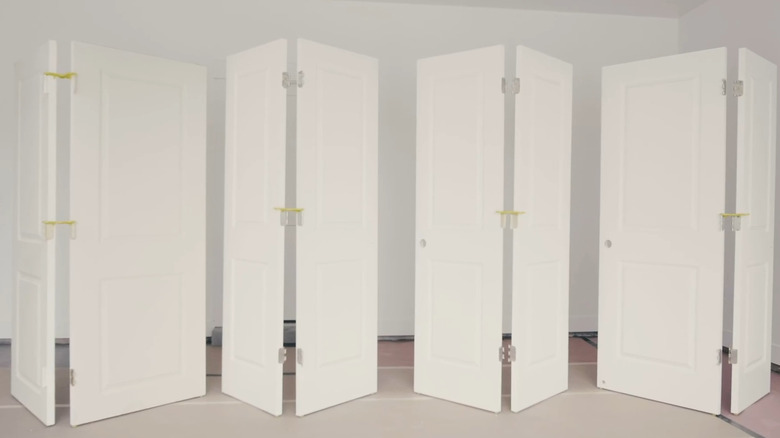The Genius Trick You Need To Paint Multiple Interior Doors In A Snap
We may receive a commission on purchases made from links.
It's no joke that time is money. Anything that can save us a bit of one, the other, or both is always welcome. We at House Digest have found another trick you need when painting your doors. By removing all of the doors you want to paint, taking them outside, and standing them up in a zig-zag pattern on a dropcloth, you can hand or spray paint both sides of the doors efficiently without the threat of paint puddles on your expensive flooring. This method requires a bit more frontloaded effort than a typical painting project, but the time you save with brush in hand may make it worth the extra work. What's more, this tip takes away the risk of getting paint on your floors.
This zig-zag technique is ideal for when you're painting your interior doors the same color. Along with painting supplies, you'll need a screwdriver, a hammer and nails, and three long pieces of scrap lumber for every two doors; thin, narrow boards like 1 inch-by-2 inch boards work great. Also, recruit at least one other helper for a few of the steps.
Make quick work of door painting
Ask a buddy to help you haul all of the doors to a designated painting area. If you're working outside, be sure to pick a day with cooperative weather. Too much humidity or wind can make this painting trick a pain. You could also do this on a smaller scale indoors, like in a basement or garage, but it's not ideal to use a paint sprayer in those situations. Lay two doors on the ground, and have your helper hold the doors up on one long edge, within a few inches of each other. Angle the doors away from each other so that when you've attached the board and stood the two doors back up, they will stand securely with the help of that angle.
While your helper has a firm grip on the doors, nail one board to the top edge of the doors and two to the bottom at opposite ends of the edge. Repeat this with each set of two doors. Have your friend help stand the joined pairs of doors in a row on drop cloths about 4 inches apart. Sand both sides of each door; move along the row, sanding one side of each door before moving on to the other side. When painting, follow this same one-side-at-a-time pattern. Once your coats of paint are dry, lay the doors on their sides again. Remove the nailed boards, and rehang your freshly updated doors.
Steps for even less work
Unscrewing the hinges from either the door, the jamb, or both can lead to difficulties when you try rehang the door. Instead, remove the pegs from the hinges by tapping a screwdriver against them with a hammer. You'll want to cover the hinges well with painter's tape before getting out your brush or spray gun. Save the trouble of removing door knobs with repurposed resealable plastic baggies; slide one over each knob, and secure the bag with painter's tape. Also cover the faceplate and latch with tape.
Gathering up scrap wood or purchasing boards expressly for this task can be a pain. Luckily, there are affordable door painting trusses designed exactly for this purpose. Reusable triangular braces hold doors together in the helpful zig-zag pattern that gives you the ease and speed of accessing both sides of the door. Some require screws to hold them in place, while others rely on a clamp like the devices in this Hinge Stand Kit for Painting and Spraying Doors.

